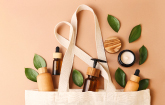AMERICAN ACADEMY OF DERMATOLOGY: HOW TO PREVENT KELOID SCARS
Board-certified dermatologist shares tips to reduce your risk
ROSEMONT, Ill. , Dec. 6, 2023 /PRNewswire/ -- Keloids are a type of raised scar that can occur after an injury, and over time they can grow much larger than the wound itself. Although keloids are not dangerous to a person's health, they can be painful and itchy, impact a person's self-esteem and restrict movement in that area of the body.
"Although anyone can develop keloids, some people are at a higher risk of developing a keloid when they scar, including people with darker skin tones and those with a family or personal history of developing keloids," said board-certified dermatologist Sonya Kenkare, MD, FAAD, director of dermatology at Rush River North in Chicago. "Fortunately, there are some ways people with keloid-prone skin can prevent a scar from becoming a full-blown keloid."
Dr. Kenkare and the AAD recommend people who are prone to keloids follow these prevention tips:
- Avoid unnecessary injury to the skin if possible. Any injury to the skin, intentional or not, can cause a keloid to form. Common causes of keloids include piercings and tattoos. If you are keloid-prone, it may be best to avoid these practices to minimize your risk of keloids.
- Practice proper wound care to reduce scarring. If you injure your skin, gently wash the area immediately with soap and water. Apply petroleum jelly to the wound to keep it moist, then cover the area with a bandage–continue to do this daily until the area heals. Repeat application of petroleum jelly and a fresh bandage daily after gently cleansing the area.
- Protect wounded skin from the sun. The sun's damaging ultraviolet rays can make your scar darker and may slow healing. To protect your skin, seek shade and cover the wound with a bandage and sun-protective clothing. For more effective protection, select clothing with an ultraviolet protection factor (UPF) number on the label. Once the wound heals, you can apply a broad-spectrum, water-resistant sunscreen with an SPF of 30 or higher, but remember to seek shade and wear sun-protective clothing when possible. Tip: Some sunscreens may leave a white residue – try a tinted sunscreen.
- Use silicone sheets or gel as soon as the wound has scabbed. These products can help prevent keloids from forming and may reduce the size of existing scars. You usually need to wear silicone sheets or gel for about six months after your wound has scabbed.
- Pay attention to new piercings. Piercings are a very common spot where keloids form. If you notice the skin around your new ear piercing start to thicken, immediately remove the earring and wear a pressure earring instead.
"People who are prone to developing keloids also should seek earlier treatment for acne to reduce the risk of scarring," said Dr. Kenkare. "A keloid won't go away on its own, so if you have questions about a scar or notice a scar start to thicken, see a board-certified dermatologist, who can discuss treatment options."
These tips are demonstrated in "How to Prevent a Keloid," a video posted to the AAD website and YouTube channel. This video is part of the AAD's "Your Dermatologist Knows" series, which offers tips people can use to properly care for their skin, hair, and nails.
To find a board-certified dermatologist in your area, visit aad.org/findaderm.
More Information
Keloid Scars: Self-Care
Keloid Scars: Signs and Symptoms
About the AAD
Headquartered in Rosemont, Ill., the American Academy of Dermatology, founded in 1938, is the largest, most influential and most representative of all dermatologic associations. With a membership of more than 20,800 physicians worldwide, the AAD is committed to advancing the diagnosis and medical, surgical, and cosmetic treatment of the skin, hair, and nails; advocating high standards in clinical practice, education and research in dermatology; and supporting and enhancing patient care because skin, hair, and nail conditions can have a serious impact on your health and well-being. For more information, contact the AAD at (888) 462-DERM (3376) or aad.org. Follow @AADskin on Facebook, TikTok, Pinterest and YouTube and @AADskin1 on Instagram.
SOURCE American Academy of Dermatology

WANT YOUR COMPANY'S NEWS FEATURED ON PRNEWSWIRE.COM?
Newsrooms &
Influencers
Digital Media
Outlets
Journalists
Opted In




Share this article